by H. F. Schwartz * (3/13)
Quick Facts…
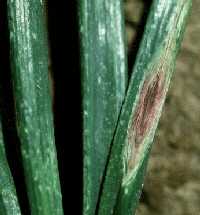 |
Figure 1: Purple blotch lesion. |
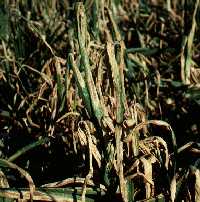 |
Figure 2: Foliage browning and wilting from purple blotch. |
- Warm, moist weather after midseason favors infection by alternaria. Cool, moist conditions near harvest favor infection by Botrytis and Peronospora.
- Pathogens enter mature onion leaves and bulbs through wounds and succulent necks after tops are removed.
- Important management factors during production include crop rotation, sanitation, weed removal, clean seed and transplants, moderate fertility programs, and fungicides.
- Dry necks before topping and cure bulbs thoroughly before storing. Keep sorted onions cool, dry and aerated.
Neck rot, gray mold, or leaf and flower blast of onions and garlic is caused by various species of the fungus Botrytisincluding B. allii, B. aclada, B. byssoidea, and B. squamosa. Botrytis cinerea can infect onion seed heads and cause brown stain. These pathogens reportedly cause storage yield losses of 20 to 30 percent in Colorado, 50 percent in Idaho and 60 percent in Europe.
Purple blotch of onion is caused by Alternaria porri. This fungus is also a pathogen of leek, garlic and chive, and is present throughout the United States and Canada. Field and storage loss estimates from this onion disease have ranged from 30 to 50 percent, and up to 100 percent in Colorado.
Downy mildew of onion is caused by Peronospora destructor. This fungus is present throughout the world. Field loss estimates in the United States vary from 25 to 50 percent.
Pathogen Survival and Spread
These fungi survive on organic matter and previously infected debris in soil, onion cull piles, and dirt or trash in storage sheds. Fungal mold (gray, cottony mycelium) and Botrytis sclerotia (irregular shaped black masses of compact mycelium) serve as overwintering structures. In Europe, Botrytis has been reported to survive in seed for more than three years and transmit to the emerging seedling. Seed transmission of the Botrytis pathogen has been detected in the Pacific Northwest.
Masses of gray Botrytis spores (fungus seeds) develop from mycelia and sclerotia during periods of high humidity or free moisture. Botrytis infection within the field will appear after prolonged moisture, especially near harvest, and temperatures between 50 to 75 degrees F. Poor ventilation, high humidity and temperatures greater than 40 degrees can produce storage rot. Condensation on onions brought from cold storage into warm, moist air can increase rot losses during transportation. Alternaria porri and Peronospora destructor spores develop in high humidity, rain or persistent dew with an optimum range of 77 to 85 degrees. Fungal activity of Alternaria is reduced by temperatures lower than 55 degrees.
Fungal spores can spread to onion foliage and bulbs in the field or storage shed by wind, water splashing, implements and insects or workers.
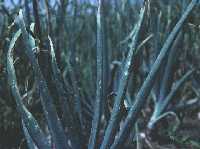 |
Figure 3: Early foliage symptoms of blast. |
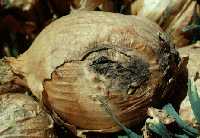 |
Figure 4: Botrytis infected cull onion; note gray mold and black sclerotia. |
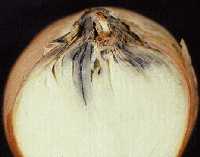 |
Figure 5: Botrytis infection of inner scales. |
Factors Favoring Epidemics
Excessive and late season applications of nitrogen fertilizer can delay onion maturity, lengthen requirements for field or storage curing, and increase storage losses from downy mildew and Botrytis neck rot. The pathogens enter plants or bulbs through wounds (hail, harvest damage); senescent or dead leaf tissue or tips (due to herbicide burn, pollution damage, water stress); closely topped necks (especially if neck tissue was green and succulent at topping); or improperly dried necks. Proximity to infected or improperly disposed onion debris and culls also can increase field and storage losses.
Purple blotch infection often follows injury caused by germinating Botrytis spores (small, whitish, sunken spots), thrips, hail, wind-blown soil or pollution. Individual leaves are more susceptible to infection as they age and young emerging leaves become more susceptible as bulbs mature. The most critical time of infection and fungal activity usually occurs after mid-July in Colorado.
Disease Symptoms
Alternaria spores germinate on onion leaves and produce a small, water-soaked spot that turns brown. The elliptical lesion enlarges, becomes zonate (target spot) and purplish. The margin may be reddish to purple and surrounded by a yellow zone. During moist weather, the surface of the lesion may be covered by brown to black masses of fungal spores.
Lesions may merge or become so numerous that they kill the leaf. Leaves become yellow then brown, and wilt downward two to four weeks after initial infection. Lesions may form on seed stalks and floral parts of seed onions, and affect seed development. Spores may be blown or washed down to the neck region and infect the outer scales of bulbs through wounds or the neck tissue. A yellow to wine-red, semi-watery decay may occur. Diseased tissue turns brown to black and dries out in the field or, more commonly, in storage.
Downy mildew symptoms appear on older leaves as elongated patches that vary in size and are slightly paler than the rest of the foliage. With moisture, these areas become covered with a violet-gray mycelium, which contains spores that may be spread to surrounding healthy tissue. The oval lesions may be violet to purple and may be confused with the initial elongated lesions of purple blotch. Affected leaves gradually become pale green and later yellow. Diseased parts, such as leaf tips, fold over and collapse. Systemically infected bulbs become soft, shrivelled and watery.
Botrytis spores kill cells and cause a small, yellow to white, oval, sunken spot or fleck on green foliage, usually late in the season. Soil-line lesions may also develop. Other Botrytis or Alternaria (purple blotch) spores may colonize this spot or tissue damaged by other factors such as thrips, mildew or pollution. Spores of B. allii also may infect leaves and not produce symptoms until storage. Successful infection can cause a rapid browning and death (blast) of onion tops within a week, reducing bulb size. The fungus sporulates on this tissue and produces secondary inoculum, which is disseminated to other plants and fields.
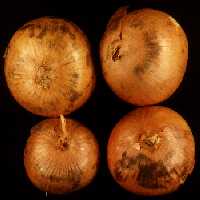 |
Figure 6: Brown stain of dried outer scales. |
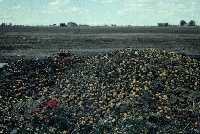 |
Figure 7: Downy mildew symptoms. |
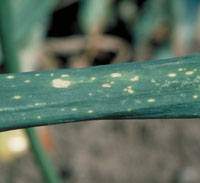 |
Figure 8: Downy mildew symptoms. |
Neck rot symptoms are most characteristic of Botrytis and often appear after bulbs are stored for two weeks or more. The fungus grows down through the inner scales and may partially rot the bulb before external injury appears. Infected scales become soft, brownish and spongy. Gray mold or thin and irregularly-shaped black sclerotia may form between scales or, more commonly, at the neck area. The neck area becomes sunken and the entire bulb can become dried out. Secondary invasion by soft rot bacteria may cause a watery rot.
Germinating Botrytis cinerea spores also can induce a superficial discoloration (brown stain) of dry outer scales with no further development or rot.
Disease Management
A three- to four-year crop rotation plays an important part in reducing the incidence of infested onion debris and of Botrytis, Peranospora and Alternaria pathogens during non-host cycles. Proper sanitation of onion debris, especially culled onions, is very important. Incorporate this material into the soil immediately after harvest. No exposed culls should be present anywhere in the growing region when the next crop is planted. Dispose of culls and trash from storage sheds at landfills by covering them with soil or bury them in deep trenches before spring. Onion culls and other debris can be sources of plant pathogens and insect pests if improperly handled. These can disseminate throughout production areas each year to the detriment of nearby and distant producers and processors.
Plant high-quality onion seed and transplants free of contamination. Follow fertility recommendations carefully and avoid excess (greater than 200 pounds per acre) or late (after July 15) applications of nitrogen. Split
nitrogen applications are recommended. Follow good weed management practices. Do not irrigate within 10 to 14 days of lifting. Late season applications of labeled fungicides such as chloro-tha-lonil, mancozeb, metalaxyl, Acrobat, Switch, Endura, Quadris, Pristine, Cabrio, or Rovral may provide some foliage protection and reduce neck contamina-tion, especially after fall
rains.
Use care during lifting and processing to minimize bruising or cutting of bulbs. Allow onions to cure properly before topping. Botrytis neck rot incidence is closely associated with harvesting and curing practices (Table 1).
Discard thick-necked onions, scallions, rots, doubles, splits, bruised, sunburned or frozen bulbs. If additional curing or drying of bulk or crated onions is required, circulate 2 cubic feet of ambient or warm air (90 to 95 degrees) per minute for five to 10 days or more. After curing properly, maintain the storage temperature at 32 to 40 degrees, and maintain humidity at 65 to 70 percent. Onions will freeze at 30.6 degrees. Monitor storage temperatures regularly.
Promote air circulation by leaving space between crates or bulked onions and outer walls of the shed. Do not stack onion bins in direct sunlight before storing or shipping, because translucent scales may occur or moisture may accumulate at the necks of bulbs.
| Table 1: Effects of harvest and curing practices for Brown Beauty onions upon Botrytis neck rot losses. | ||||
| Harvest practice (percent of green foliage topped) | Percent neck rot loss after 10 weeks storage* | |||
|---|---|---|---|---|
| Natural infection Field cured for |
Artificial inoculation Field cured for |
|||
| 0 days | 10 days | 0 days | 10 days | |
| 0 | 10 a | 7 a | 57 de | 33 bc |
| 50 | 67 de | 27 ab | 100 f | 77 e |
| 100 | 77 e | 53 cd | 100 f | 100 f |
| *Means followed by the same letter are not statistically different (FLSD=0.05). 1984 experimental results from H.F. Schwartz and Dan Sullivan, Colorado State University. | ||||
*Colorado State University Extension plant pathologist and professor, bioagricultural science and pest management. 9/99. Portions of this fact sheet were taken from research and Colorado Onion Production and IPM, Bulletin 547A, by H.F. Schwartz and M.E. Bartolo. Revised 5/11.
Go to top of this page.





